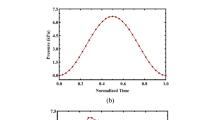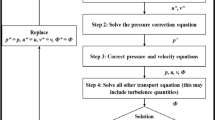Abstract
We investigated whether local hemodynamics were associated with sites of plaque erosion and hypothesized that patients with plaque erosion have locally elevated WSS magnitude in regions where erosion has occurred. We generated 3D, patient-specific models of coronary arteries from biplane angiographic images in 3 human patients with plaque erosion diagnosed by optical coherence tomography. Using computational fluid dynamics, we simulated pulsatile blood flow and calculated both wall shear stress (WSS) and oscillatory shear index (OSI). We also investigated anatomic features of plaque erosion sites by examining branching and local curvature in X-ray angiograms of barium-perfused autopsy hearts. Neither high nor low magnitudes of mean WSS were associated with sites of plaque erosion. OSI and local curvature were also not associated with erosion. Anatomically, 8 of 13 hearts had a nearby bifurcation upstream of the site of plaque erosion. This study provides preliminary evidence that neither hemodynamics nor anatomy are predictors of plaque erosion, based upon a very unique dataset. Our sample sizes are small, but this dataset suggests that high magnitudes of WSS, one potential mechanism for inducing plaque erosion, are not necessary for erosion to occur.









Similar content being viewed by others
References
Brooks, A. R., P. I. Lelkes, and G. M. Rubanyi. Gene expression profiling of vascular endothelial cells exposed to fluid mechanical forces: relevance for focal susceptibility to atherosclerosis. Endothelium 11(1):45–57, 2004. doi:10.1080/10623320490432470.
Campbell, I. C., J. Ries, S. S. Dhawan, A. A. Quyyumi, W. R. Taylor, and J. N. Oshinski. Effect of inlet velocity profiles on patient-specific computational fluid dynamics simulations of the carotid bifurcation. J. Biomech. Eng. 134(5):051001, 2012. doi:10.1115/1.4006681.
Chatzizisis, Y. S., M. Jonas, A. U. Coskun, R. Beigel, B. V. Stone, C. Maynard, et al. Prediction of the localization of high-risk coronary atherosclerotic plaques on the basis of low endothelial shear stress: an intravascular ultrasound and histopathology natural history study. Circulation 117(8):993–1002, 2008. doi:10.1161/CIRCULATIONAHA.107.695254.
Durand, E., A. Scoazec, A. Lafont, J. Boddaert, A. Al Hajzen, F. Addad, et al. In vivo induction of endothelial apoptosis leads to vessel thrombosis and endothelial denudation: a clue to the understanding of the mechanisms of thrombotic plaque erosion. Circulation 109(21):2503–2506, 2004. doi:10.1161/01.CIR.0000130172.62481.90.
Eshtehardi, P., J. Luke, M. C. McDaniel, and H. Samady. Intravascular imaging tools in the cardiac catheterization laboratory: comprehensive assessment of anatomy and physiology. J. Cardiovasc. Transl. Res. 4(4):393–403, 2011. doi:10.1007/s12265-011-9272-4.
Farb, A., A. P. Burke, A. L. Tang, T. Y. Liang, P. Mannan, J. Smialek, et al. Coronary plaque erosion without rupture into a lipid core. A frequent cause of coronary thrombosis in sudden coronary death. Circulation 93(7):1354–1363, 1996.
Feldman, C. L., and P. H. Stone. Intravascular hemodynamic factors responsible for progression of coronary atherosclerosis and development of vulnerable plaque. Curr. Opin. Cardiol. 15(6):430–440, 2000.
Formaggia, L., F. Nobile, A. Quarteroni, and A. Veneziani. Multiscale modelling of the circulatory system: a preliminary analysis. Comput. Vis. Sci. 2(2):75–83, 1999.
Formaggia, L., A. Quarteroni, and A. Veneziani. Multiscale models of the vascular system. In: Cardiovascular Mathematics, edited by L. Formaggia, A. Quarteroni, and A. Veneziani. Milan: Springer, 2009.
Fry, D. L. Acute vascular endothelial changes associated with increased blood velocity gradients. Circ. Res. 22(2):165–197, 1968.
Fujii, K., D. Kawasaki, M. Masutani, T. Okumura, T. Akagami, T. Sakoda, et al. OCT assessment of thin-cap fibroatheroma distribution in native coronary arteries. JACC Cardiovasc. Imaging 3(2):168–175, 2010. doi:10.1016/j.jcmg.2009.11.004.
Fukumoto, Y., T. Hiro, T. Fujii, G. Hashimoto, T. Fujimura, J. Yamada, et al. Localized elevation of shear stress is related to coronary plaque rupture: a 3-dimensional intravascular ultrasound study with in vivo color mapping of shear stress distribution. J. Am. Coll. Cardiol. 51(6):645–650, 2008. doi:10.1016/j.jacc.2007.10.030.
Fuster, V., and J. H. Chesebro. Atherosclerosis—A. Pathogenesis: initiation, progression, acute coronary syndromes, and regression. In: Mayo Clinic Practice of Cardiology3rd, edited by E. Giuliani, B. Gersh, M. McGoon, D. Hayes, and H. Schaff. St. Louis: Mosby, 1996, pp. 1056–1081.
Gertz, S. D., G. Uretsky, R. S. Wajnberg, N. Navot, and M. S. Gotsman. Endothelial cell damage and thrombus formation after partial arterial constriction: relevance to the role of coronary artery spasm in the pathogenesis of myocardial infarction. Circulation 63(3):476–486, 1981.
Girasis, C., J. C. Schuurbiers, T. Muramatsu, J. P. Aben, Y. Onuma, S. Soekhradj, et al. Advanced three-dimensional quantitative coronary angiographic assessment of bifurcation lesions: methodology and phantom validation. EuroIntervention 8(12):1451–1460, 2013. doi:10.4244/EIJV8I12A219.
Goubergrits, L., E. Wellnhofer, U. Kertzscher, K. Affeld, C. Petz, and H. C. Hege. Coronary artery WSS profiling using a geometry reconstruction based on biplane angiography. Ann. Biomed. Eng. 37(4):682–691, 2009. doi:10.1007/s10439-009-9656-7.
Groen, H. C., F. J. Gijsen, A. van der Lugt, M. S. Ferguson, T. S. Hatsukami, A. F. van der Steen, et al. Plaque rupture in the carotid artery is localized at the high shear stress region: a case report. Stroke 38(8):2379–2381, 2007. doi:10.1161/STROKEAHA.107.484766.
Heywood, J. G., R. Rannacher, and S. Turek. Artificial Boundaries and Flux and Pressure Conditions for the Incompressible Navier-Stokes Equations. Int. J. Numer. Methods Fluids 22(5):325–352, 1996. doi:10.1002/(sici)1097-0363(19960315)22:5<325::aid-fld307>3.0.co;2-y.
Knot, H. J., K. M. Lounsbury, J. E. Brayden, and M. T. Nelson. Gender differences in coronary artery diameter reflect changes in both endothelial Ca2+ and ecNOS activity. Am. J. Physiol. 276(3 Pt 2):H961–H969, 1999.
Kolodgie, F. D., A. P. Burke, T. N. Wight, and R. Virmani. The accumulation of specific types of proteoglycans in eroded plaques: a role in coronary thrombosis in the absence of rupture. Curr. Opin. Lipidol. 15(5):575–582, 2004.
Koskinas, K. C., C. L. Feldman, Y. S. Chatzizisis, A. U. Coskun, M. Jonas, C. Maynard, et al. Natural history of experimental coronary atherosclerosis and vascular remodeling in relation to endothelial shear stress: a serial, in vivo intravascular ultrasound study. Circulation 121(19):2092–2101, 2010. doi:10.1161/CIRCULATIONAHA.109.901678.
Kramer, M. C., S. Z. Rittersma, R. J. de Winter, E. R. Ladich, D. R. Fowler, Y. H. Liang, et al. Relationship of thrombus healing to underlying plaque morphology in sudden coronary death. J. Am. Coll. Cardiol. 55(2):122–132, 2010. doi:10.1016/j.jacc.2009.09.007.
Ku, D. N. Blood flow in arteries. Annu. Rev. Fluid Mech. 29:399–434, 1997. doi:10.1146/annurev.fluid.29.1.399.
Ku, D. N., and D. P. Giddens. Pulsatile flow in a model carotid bifurcation. Arteriosclerosis 3(1):31–39, 1983.
Ku, D. N., D. P. Giddens, C. K. Zarins, and S. Glagov. Pulsatile flow and atherosclerosis in the human carotid bifurcation. Positive correlation between plaque location and low oscillating shear stress. Arteriosclerosis 5(3):293–302, 1985.
Loree, H. M., R. D. Kamm, R. G. Stringfellow, and R. T. Lee. Effects of fibrous cap thickness on peak circumferential stress in model atherosclerotic vessels. Circ. Res. 71(4):850–858, 1992.
Lovett, J. K., and P. M. Rothwell. Site of carotid plaque ulceration in relation to direction of blood flow: an angiographic and pathological study. Cerebrovasc. Dis. 16(4):369–375, 2003. doi:10.1159/000072559.
Malek, A. M., S. L. Alper, and S. Izumo. Hemodynamic shear stress and its role in atherosclerosis. JAMA 282(21):2035–2042, 1999.
Mallat, Z., and A. Tedgui. Current perspective on the role of apoptosis in atherothrombotic disease. Circ. Res. 88(10):998–1003, 2001.
McCord, B. N. Fatigue of Atherosclerotic Plaque. Georgia: Georgia Institute of Technology, 1992.
McDaniel, M. C., E. M. Galbraith, A. M. Jeroudi, O. R. Kashlan, P. Eshtehardi, J. Suo, et al. Localization of culprit lesions in coronary arteries of patients with ST-segment elevation myocardial infarctions: relation to bifurcations and curvatures. Am. Heart J. 161(3):508–515, 2011. doi:10.1016/j.ahj.2010.11.005.
Moore, J. A., D. A. Steinman, S. Prakash, K. W. Johnston, and C. R. Ethier. A numerical study of blood flow patterns in anatomically realistic and simplified end-to-side anastomoses. J. Biomech. Eng. 121(3):265–272, 1999.
Para, A., D. Bark, A. Lin, and D. Ku. Rapid platelet accumulation leading to thrombotic occlusion. Ann. Biomed. Eng. 39(7):1961–1971, 2011. doi:10.1007/s10439-011-0296-3.
Prati, F., S. Uemura, G. Souteyrand, R. Virmani, P. Motreff, L. Di Vito, et al. OCT-based diagnosis and management of STEMI associated with intact fibrous cap. JACC Cardiovasc. Imaging 6(3):283–287, 2013. doi:10.1016/j.jcmg.2012.12.007.
Rathore, S., M. Terashima, H. Matsuo, Y. Kinoshita, M. Kimura, E. Tsuchikane, et al. Association of coronary plaque composition and arterial remodelling: a optical coherence tomography study. Atherosclerosis. 221(2):405–415, 2012. doi:10.1016/j.atherosclerosis.2011.10.018.
Samady, H., P. Eshtehardi, M. C. McDaniel, J. Suo, S. S. Dhawan, C. Maynard, et al. Coronary artery wall shear stress is associated with progression and transformation of atherosclerotic plaque and arterial remodeling in patients with coronary artery disease. Circulation 124(7):779–788, 2011. doi:10.1161/CIRCULATIONAHA.111.021824.
Santamarina, A., E. Weydahl, J. M. Siegel, Jr., and J. E. Moore, Jr. Computational analysis of flow in a curved tube model of the coronary arteries: effects of time-varying curvature. Ann. Biomed. Eng. 26(6):944–954, 1998.
Schuurbiers, J. C., N. G. Lopez, J. Ligthart, F. J. Gijsen, J. Dijkstra, P. W. Serruys, et al. In vivo validation of CAAS QCA-3D coronary reconstruction using fusion of angiography and intravascular ultrasound (ANGUS). Catheter. Cardiovas. Interv. 73(5):620–626, 2009. doi:10.1002/ccd.21872.
Shah, P. K. Mechanisms of plaque vulnerability and rupture. J. Am. College Cardiol. 41(4 Suppl S):15S–22S, 2003.
Shah, P. K. Inflammation and plaque vulnerability. Cardiovasc. Drugs Ther. 23(1):31–40, 2009. doi:10.1007/s10557-008-6147-2.
Sumi, T., A. Yamashita, S. Matsuda, S. Goto, K. Nishihira, E. Furukoji, et al. Disturbed blood flow induces erosive injury to smooth muscle cell-rich neointima and promotes thrombus formation in rabbit femoral arteries. J. Thromb. Haemost. 8(6):1394–1402, 2010. doi:10.1111/j.1538-7836.2010.03843.x.
Tearney, G. J., E. Regar, T. Akasaka, T. Adriaenssens, P. Barlis, H. G. Bezerra, et al. Consensus standards for acquisition, measurement, and reporting of intravascular optical coherence tomography studies: a report from the International Working Group for Intravascular Optical Coherence Tomography Standardization and Validation. J. Am. Coll. Cardiol. 59(12):1058–1072, 2012. doi:10.1016/j.jacc.2011.09.079.
Timmins, L. H., J. Suo, P. Eshtehardi, S. S. Dhawan, M. C. McDaniel, J. N. Oshinski, et al. Geometric and Hemodynamic Evaluation of 3-Dimensional Reconstruction Techniques for the Assessment of Coronary Artery Wall Shear Stress in the Setting of Clinical Disease Progression. Farmington, PA: ASME, 2011.
Tricot, O., Z. Mallat, C. Heymes, J. Belmin, G. Leseche, and A. Tedgui. Relation between endothelial cell apoptosis and blood flow direction in human atherosclerotic plaques. Circulation 101(21):2450–2453, 2000.
van der Wal, A. C., A. E. Becker, C. M. van der Loos, and P. K. Das. Site of intimal rupture or erosion of thrombosed coronary atherosclerotic plaques is characterized by an inflammatory process irrespective of the dominant plaque morphology. Circulation 89(1):36–44, 1994.
Vignon-Clementel, I. E., C. Alberto Figueroa, K. E. Jansen, and C. A. Taylor. Outflow boundary conditions for three-dimensional finite element modeling of blood flow and pressure in arteries. Comput. Methods Appl. Mech. Eng. 195(29–32):3776–3796, 2006. doi:10.1016/j.cma.2005.04.014.
Virmani, R., A. P. Burke, A. Farb, and F. D. Kolodgie. Pathology of the vulnerable plaque. J. Am. Coll. Cardiol. 47(8 Suppl):C13–C18, 2006. doi:10.1016/j.jacc.2005.10.065.
Wellnhofer, E., L. Goubergrits, U. Kertzscher, and K. Affeld. In-vivo coronary flow profiling based on biplane angiograms: influence of geometric simplifications on the three-dimensional reconstruction and wall shear stress calculation. Biomed. Eng. Online 5:39, 2006. doi:10.1186/1475-925X-5-39.
Wootton, D. M., C. P. Markou, S. R. Hanson, and D. N. Ku. A mechanistic model of acute platelet accumulation in thrombogenic stenoses. Ann. Biomed. Eng. 29(4):321–329, 2001. doi:10.1114/1.1359449.
Yang, F., R. M. Minutello, S. Bhagan, A. Sharma, and S. C. Wong. The impact of gender on vessel size in patients with angiographically normal coronary arteries. J. Interv. Cardiol. 19(4):340–344, 2006. doi:10.1111/j.1540-8183.2006.00157.x.
Yoshizumi, M., J. Abe, K. Tsuchiya, B. C. Berk, and T. Tamaki. Stress and vascular responses: atheroprotective effect of laminar fluid shear stress in endothelial cells: possible role of mitogen-activated protein kinases. J. Pharmacol. Sci. 91(3):172–176, 2003.
Zeng, D., Z. Ding, M. H. Friedman, and C. R. Ethier. Effects of cardiac motion on right coronary artery hemodynamics. Ann. Biomed. Eng. 31(4):420–429, 2003.
Acknowledgments
This material is based upon work supported by an American Heart Association Predoctoral Fellowship (11PRE7040000, Campbell) and an American Heart Association Postdoctoral Fellowship (11POST7210012, Timmins), by the National Science Foundation Graduate Research Fellowship under Grant No. DGE-0644493, and by the National Institutes of Health Bioengineering Research Partnership Grant No. R01 HL70531. The Robert M. Nerem International Travel Award supported training for the execution of this study.
Author information
Authors and Affiliations
Corresponding author
Additional information
Associate Editor Ajit P. Yoganathan oversaw the review of this article.
Rights and permissions
About this article
Cite this article
Campbell, I.C., Timmins, L.H., Giddens, D.P. et al. Computational Fluid Dynamics Simulations of Hemodynamics in Plaque Erosion. Cardiovasc Eng Tech 4, 464–473 (2013). https://doi.org/10.1007/s13239-013-0165-3
Received:
Accepted:
Published:
Issue Date:
DOI: https://doi.org/10.1007/s13239-013-0165-3




